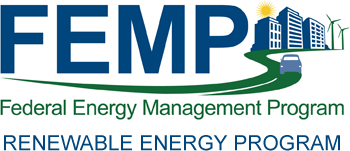Introduction
Within This Page
- Introduction
- Description
- Application
- Operations and Maintenance
- Special Considerations
- Relevant Codes and Standards
- Additional Resources
THIS PAGE SUPPORTED BY THE
Water heating accounts for a substantial portion of energy use at many residential, commercial, institutional, and Federal facilities. Nationwide, approximately 18% of energy use in residential buildings and 4% in commercial buildings is for water heating. Solar water heating systems, which use the sun's energy rather than electricity or gas to heat water, can efficiently serve up to 80% of hot water needs—with no fuel cost or pollution and with minimal operation and maintenance (O&M) expense. Solar water heating currently represents less than 1% of the potential water heating market (about 1% of residential buildings have solar water heating, fulfilling about two-thirds of each building's water heating requirements).
Solar water heating systems can be used effectively throughout the United States at facilities that have an appropriate near-south-facing roof or nearby un-shaded grounds for installation of a collector. A variety of building types can take advantage of solar water heating systems including swimming pools, residences, hotels, laundries, hospitals, prisons, and kitchens. Solar water heating systems are most cost effective for facilities with the following characteristics:
- Water heating load is constant throughout the year (not vacant in summer)
- Water heating load is constant throughout the week (use solar heat every day)
- Cost of fuel used to heat water is high (examples include electricity, which represents 46% of the water heating market, and propane, which represents 2% of the market in remote locations)
- A sunny climate (helpful but not required—in 2003, the three largest markets were Florida, California, and New Jersey).
This overview is intended to provide specific details for Federal agencies considering solar water heating technologies as part of a new construction project or major renovation.
Description
A solar water heating system is made up of several key components including:
- Solar collectors
- Thermal storage
- System controls/controller
- A back-up, conventional water heater.
Solar water heating is a reliable and renewable energy technology used to heat water. Sunlight strikes and heats an absorber surface within a solar collector or an actual storage tank. Either a heat-transfer fluid or the actual potable water to be used flows through tubes attached to the absorber and picks up the heat from it (systems with a separate heat-transfer-fluid loop include a heat exchanger that then heats the potable water.) The heated water is stored in a separate preheat tank or a conventional water heater tank until needed. If additional heat is needed, it is provided by electricity or fossil-fuel energy by the conventional water heating system.
Thermal storage is generally required to couple the timing of the intermittent solar resource with the timing of the hot water load. In general, 1 to 2 gallons of storage water per square foot of collector area is adequate. Storage can either be potable water or non-potable water if a load side heat exchanger is used. For small systems, storage is most often in the form of glass-lined steel tanks.
Active systems have a "delta T" (temperature difference) controller to start and stop the pumps. If the temperature in the solar collector outlet exceeds the temperature in the bottom of the storage tank by a set amount, such as 6°C, or 42.8°F, the controller starts the pump. When this temperature difference falls below another set value, such as 2°C, or 35.6°F, the controller stops the pumps. The controller will also have a high-limit function to turn off the pumps if the temperature in the storage tank exceeds a third setting, such as 90°C, or 194°F. Due to the simplicity and low cost of a delta T controller, it is wise to keep controls independent of any whole-plant energy management system, although it is desirable to include some indication of system performance, such as output from a Btu meter or preheat tank temperature sensor in the building control system.
Solar water heaters save energy by preheating water to the conventional heater. Solar domestic hot water systems are usually designed to meet 40% to 70% of the water heating load. A back-up, conventional heater is still needed to meet 100% of the peak hot water demand generally, especially for cloudy days or for when the solar system is down for service.
Types and Costs of Technology
Types of Collectors
Although solar water heating systems all use the same basic method for capturing and transferring solar energy, they do so with three specific technologies that distinguish different collectors and systems. The distinctions are important because different water heating needs in various locations are best served by certain types of collectors and systems.
Materials and components used in solar water heating systems vary depending on the expected operating temperature range.

Low-temperature systems (unglazed) usually operate at low temperature, up to 18°F (10°C) above ambient temperature, and are most often used for heating swimming pools. Often, the pool water is colder than the air, and insulating the collector would be counter-productive. Low-temperature collectors are extruded from polypropylene or other polymers with ultraviolet stabilizers. Flow passages for the pool water are molded directly into the absorber plate, and pool water is circulated through the collectors with the pool filter circulation pump. As of 2004, swimming pool heaters cost $10 to $40/ft².
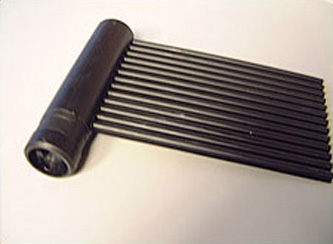
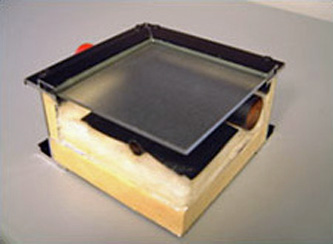
Small sample of an unglazed, low-temperature solar collector showing flow passages and header pipe.
Small sample of mid-temperature flat plate collector showing cover glass, insulation, copper absorber plate, and flow passages.
Mid-temperature systems produce water 18°F to 129°F (10°C to 50°C) above outside temperature, and are most often used for heating domestic hot water. However, it is also possible to use mid-temperature solar water heating collectors for space heating in conjunction with fan-forced convection coils or radiant floors.
Mid-temperature collectors are usually flat plates insulated by a low-iron cover glass and fiberglass or polyisocyanurate insulation. Reflection and absorption of sunlight in the cover glass reduces the efficiency at low temperature differences, but the glass is required to retain heat at higher temperatures. A copper absorber plate with copper tubes welded to the fins is used. In order to reduce radiant losses from the collector, the absorber plate is often treated with a black nickel selective surface, which has a high absorptivity in the short-wave solar spectrum, but a low-emissivity in the long-wave thermal spectrum. As of 2004, mid-temperature systems cost $90 to $120/ft² of collector area.
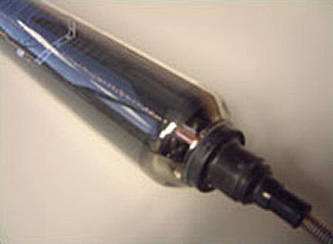
Close-up view of an evacuated glass tube with black copper absorber plate inside.
High-temperature systems use evacuated tubes around the receiver tube to provide high levels of insulation and often use focusing curved mirrors to concentrate sunlight. High-temperature systems are required for absorption cooling or electricity generation, but are used for mid-temperature applications such as commercial or institutional water heating as well. Due to the tracking mechanism required to keep the focusing mirrors facing the sun, high-temperature systems are usually very large and mounted on the ground adjacent to a facility. Evacuated tube collectors themselves cost about $75/ft², but use of curved mirrors and economies of scale get this cost down for large system sizes to a relatively low cost of $40 to 70/ft² (2004).
Solar collector efficiency varies depending on how warm the collector inlet temperature is relative to the ambient air temperature. The following figure shows typical efficiency curves for the three collector types. Note that inexpensive, unglazed collectors are very efficient at low ambient temperatures, but efficiency drops off very quickly as temperature increases. They offer the best performance for low temperature applications, but glazed collectors are required to efficiently achieve higher temperatures. Evacuated tubes are necessary to attain higher water temperatures, as needed in cooling and some industrial process heat applications.
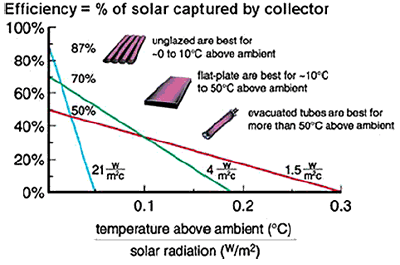
Efficiency of common collector types
Types of Solar Water Heating Systems
Solar water heating system types are classified by the following types:
- Active. Requires electric power to activate pumps and/or controls.
- Passive. Relies on buoyancy (natural convection) rather than electric power to circulate the heated water. Thermosyphon systems locate a storage tank above the solar collector, while integrated-collector-storage collectors place the storage inside the collector.
- Direct. Heats potable water directly in the collector.
- Indirect. Heats propylene glycol or other heat transfer fluid in the collector and transfers heat to potable water via a heat exchanger.
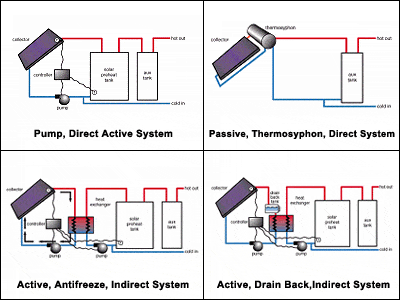
Types of solar water heating systems
Technology Costs
System costs will vary depending on geographic location, water usage, and utility rates. Installed costs per square foot for collectors range from as low as $10 for low-temperature systems used to heat pools to as high as $225 for single, small, residential-scale systems. Lowest cost is achieved with large central-plant systems used to heat large facilities with high-volume, high-temperature water requirements. However, most glazed water heating systems fall within the range of installed costs of $60 to $150 per square foot of collector area. New construction systems usually have better economics than retrofit projects because of reduced installation expenses. The new low-cost plastic solar water heating kits have significantly reduced installation costs, but they don't perform as well as some traditional systems under higher-temperature conditions.
Costs will vary depending on geographic location and size of system. Installed costs per square foot for complete systems range from $60 per square foot for a large system in a location with a competitive solar industry to $225 per square foot for a small system in a remote location. Cost also depends on system type, with unglazed low-temperature collectors costing much less than better insulated ones.
Application
When deciding whether solar water heating systems are a good match for a particular construction project, several factors must be considered. Solar water heating systems are viable in many applications throughout the country, but special consideration should be given to projects where:
- The avoided cost of energy is high (gas is not available, electricity rates are above $0.034/kWh)
- There is a dependable, consistent hot water requirement (such as enlisted quarters, laboratories, or hospitals)
- There is a reasonably high daily average solar radiation rate on a tilted surface (in excess of 4.5 kWh/m²/day—although if the avoided cost is high enough, solar water heating is effective in most climates)
- Energy security is important (such as on an international base where energy supplies could be interrupted).
For large facilities, active, indirect systems are most frequently used. For smaller facilities in mild climates with a modest freeze threat, passive direct or indirect systems are also a viable option.
The Federal Energy Management Program (FEMP)'s Guide to Integrating Renewable Energy in Federal Construction has more information on assessing renewable energy options.
Economics
Monetary savings from installing a solar water heater depend on a variety of factors, including climate, how much hot water is used at the location, conventional fuel costs, the water temperature required, and system performance. On average, however, the installation of a solar water heater will decrease water heating bills by 50% to 80%.
A general rule of thumb for Federal facilities is that a solar water heating installation will pay for itself within 10 to 15 years when installed against electricity. As specified by the Energy Independence and Security Act of 2007, the expected life of a solar water heating system used for life-cycle analysis is 40 years, which means a facility can look forward to as much as 30 years of "free" energy.
New construction systems usually have better economics than retrofit projects because of reduced installation expenses. The new low-cost plastic solar water heating kits have significantly reduced installation costs, but they do not perform as well as some traditional systems under high-temperature, high-volume conditions. For Federal facilities, a renewable energy installation should pay for itself within its system lifetime including the time/value of money for it to be cost effective. The key parameter is savings-to-investment ratio. A savings-to-investment ratio of greater than 1.0 would be cost effective. Federal life-cycle cost analysis standards are outlined in regulation 10 C.F.R. § 436.
Agencies can often improve system economics and access additional incentives when alternate project funding mechanisms are used. Among the renewable energy project funding options are energy savings performance contract and utility programs. FEMP has established indefinite quantity contracts under which any Federal agency can issue delivery orders for solar water heating systems in an energy savings performance contract. Several utilities offer rebates, leases, or other solar water heating programs.
FEMP's Guide to Integrating Renewable Energy in Federal Construction provides further information about renewable energy project funding for Federal construction projects.
A complete listing of incentives is provided in the Database of State Incentives for Renewables & Efficiency (DSIRE). Contact the local utility company for more details.
Assessing Resource Availability
Several factors are involved in determining whether a site has a good resource for solar water heating. The first is the amount of solar radiation that the site receives. The first map shows the basic solar radiation available in the United States. As noted previously, many sites with an average solar radiation rate above 4.5 kWh/m² per day should be carefully considered for solar water heating.
But, even a site with a less attractive solar resource can have good potential for solar water heating if the energy rate it offsets is high enough or incentives are available. To depict this, the National Renewable Energy Laboratory (NREL) has put together a series of maps that combine solar resource with an assumed system cost and depict factors needed to make a system cost effective. These maps are available for systems that will offset electricity use and for those that will offset natural gas.
As an example, the two maps below depict the electricity rate needed to make a solar water heating system cost effective. One map assumes an installed system cost of $75 per square foot of collector area (likely for a larger, commercial system) and the second assumes a cost of $150 per square foot (smaller system). The first map indicates that much of the country could cost-effectively use solar water heating at $75/ft² if the offset electricity cost is above $0.06/kWh. Available incentives would improve this even more.
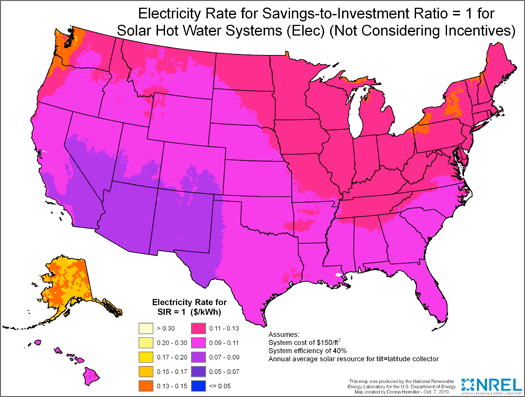
Electricity rates needed to make a solar water heating system that costs $75/ft² cost effective. This map does not account for any available financial incentives.
The second map also includes incentives available to Federal agencies. Even at the elevated system costs, electricity rates below $0.05/kWh would enable cost-effective solar water heating in Arizona or Wisconsin, but a system in Wyoming might need to offset a retail electricity rate of $0.09 to $0.11/kWh to break even. Of course, break-even rates change significantly if the system cost varies from the maps' assumptions or if incentives change from the ones depicted.
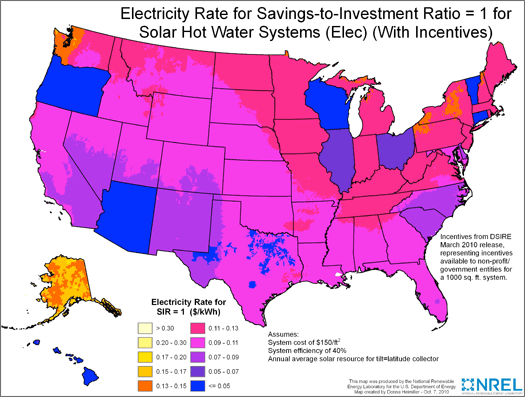
Electricity rates needed to make a solar water heating system that costs $150/ft² cost effective. This map accounts for financial incentives.
Analysis Tools
To determine if a project is a possible candidate for solar water heating, agencies can use Federal Renewable Energy Screening Assistant software. Developed by NREL, this Microsoft Windows-based software tool screens Federal renewable energy projects for economic feasibility. It also evaluates many renewable technologies including solar water heating, photovoltaics and wind. A somewhat more detailed screening tool is provided by RETScreen International.
Once preliminary viability has been established, it will eventually be necessary to evaluate system performance to generate more precise engineering data and economic analysis. This can be accomplished by using hourly simulation software or by manual correlation methods based on the results of hourly simulations. For this task, consider using:
- F-CHART, a correlation method, available from the University of Wisconsin
- TRNSYS, a transient systems simulation program available from the University of Wisconsin.
Design Considerations
Solar water heating systems should be designed to minimize life-cycle cost. It is never cost effective to design a system that provides 100% of the load with solar because of the excessive investment in collector area and storage volume. The life-cycle cost can be minimized by designing a system that meets 100% of the load on the sunniest day of the year. Such a system will usually produce about 70% of the annual load. Other design considerations include maintenance, freeze protection, overheating protection, aesthetics of the collector mount, and orientation. Also, utility rebate programs may impose additional design requirements. For example, a solar water heating system in Hawaii must meet 90% of the load in order to qualify for rebates from the Hawaiian Electric Company.
When designing a solar water heating system, there are specific steps that are recommended. First, it is important to ensure the proper location of the solar collectors. The best annual energy delivery is achieved by facing toward the equator with a tilt up from the horizontal equal to the local latitude. Recent studies show that adequate performance may be obtained with tilt angles and orientations that vary from this considerably.
In the continental United States, collectors should be rotated within 30° of true (not magnetic) south for maximum performance. Also, it is important to optimize the tilt of the collecting array. Surfaces tilted up from the horizontal at an angle of latitude minus 15° maximize summer solar gains, but reduce winter gains. Surfaces tilted up at latitude plus 15° maximize winter solar gains, and result in a solar delivery that is more uniform throughout the year. A tilt angle equal to the local latitude provides close to the maximum year-round solar gains and is usually appropriate for solar water heating. It is usually acceptable to mount the collectors flush on a pitched roof—and as close to the optimal orientation as possible—in order to reduce installed costs and improve aesthetics. U.S. solar resource maps and tables are posted on NREL's Renewable Resource Data Center.
Second, damage can be caused if water freezes in the collector flow passages or connecting piping. There are several strategies for protection against freeze damage. The most common is to circulate a solution of propylene glycol (never use toxic ethylene glycol) and water in the collector loop of an indirect system. Another strategy is to drain the water from the collector back into a drain-back tank sized to contain all of the collector loop fluid. This drain-back configuration has the added advantage of protecting the system from excessive temperatures if hot water consumption is reduced due to seasonal use patterns, remodeling, or vacations. Where freezing is uncommon, a controller function that circulates water in the collector loop when temperatures approach freezing in conjunction with freeze protection values may be adequate, but can significantly reduce net energy gain.
Another step is to provide a tempering valve and bypass capability. The tempering valve is very important to ensure that water with a consistent temperature is delivered at the taps, even when solar storage is well above the water heater setpoint. Bypass piping and valves allow the conventional system to provide hot water if the solar heating system is down for any reason.
Finally, conducting periodic maintenance for all systems is necessary. Check for obvious damage such as broken collector glazing or wet pipe insulation. Check pH and freeze point of heat transfer fluids. Compare control temperature sensors against thermometers to be sure sensors are functioning. Also, be sure to check proper pump operation and other system functions. For a simple comprehensive test, check the preheat tank temperature—it should be hot after a sunny day. More elaborate quantitative tests can be found in the ASHRAE design guides. For more information, see the Building Commissioning and Reliability-Centered Maintenance pages.
Specifically, when integrating a solar water heating system into a larger construction project, be sure to:
- Include solar panels on the roof with south-facing access in the architectural program and structural design
- Design the roof to handle additional weight of solar water heating panels, including their physical weight and wind loading
- Consider integrated solar thermal roof designs
- Minimize roof penetrations
- Include enough space in the heating equipment room to accommodate solar heating tanks, pumps, and equipment
- Provide a pathway for plumbing and wiring from the roof to the equipment room
- When including some space heating along with the water heating, integrate the solar thermal system with the building heating system through the heat exchanger for space heating
For large systems, a lower cost is usually achieved by mounting the solar collectors on un-shaded ground area adjacent to the building and near the heating equipment to prevent losses.
An excellent guide to design and installation of commercial-scale solar water heaters was produced in the 1980s by ASHRAE, based upon experiences with active solar in the Solar in Federal Buildings Program. The three volumes cover design, installation, and O&M manual preparation, and are available from the Solar Rating and Certification Corporation.
Operation and Maintenance
O&M costs of each solar water heating system are estimated at half of 0.5–2% of the initial cost per year, depending on the system type and design. Oamp;M is similar to that required of any hydronic heating loop and may be provided by site staff, with experts called in if something should fail. Regularly scheduled maintenance includes:
- Checking the solar collectors and frames for any damage and noting the location of broken or leaking tubes for replacement
- Examining the proper position of all valves
- Inspecting and maintaining the pipe insulation and protective materials to minimize losses and maintain freeze protection
- Checking the tightness of mounting connectors and repairing any bent or corroded mounting components
- Determining if any new objects, such as vegetation growth, are shading the array and move them if possible
- Cleaning the array annually with plain water or mild dishwashing detergent (do not use brushes, any types of solvents, abrasives, or harsh detergents)
- Checking all connecting piping for leaks and repairing any damaged components
- Examining plumbing for signs of corrosion
- Observing operational indicators of temperature and pressure to ensure proper operation of pumps and controls
- Ensuring that the pump is running on a sunny day and not at night
- Using an insolation meter to measure incident sunlight and simultaneously observe temperature and energy output on the controller faceplate. Compare these readings with the original efficiency of the system (See ASHRAE handbooks for more tests).
- Checking status indicators of the controller faceplate and comparing indicators with measured values
- Documenting all O&M activities in a workbook and making that workbook available to all service personnel
- Flushing the potable water storage tank every year to remove sediment
- Flushing-and-filling the heat transfer fluid every 10 years
- Flushing the system to remove scaling due to poor water quality, as required (only potable water portions of the system)
- Replacing the sacrificial anode in the storage tank as needed.
Additional maintenance can include replacing temperature sensors that have been disconnected, replacing pump capacitors and motors, repairing leaks or damage from freezing, and replacing glass broken by hail or vandalism. At some point in time—typically in excess of 10 years—the storage tank may need to be replaced.
Special Considerations
The special considerations to consider when designing and installing solar hot water systems include solar access, solar rights, and relevant codes and standards.
Solar Access and Solar Rights
Solar access laws protect a consumer's right to install and operate solar energy systems on a home or business, including the property's access to sunlight. Access to sunlight refers to the ability of one property to continue to receive sunlight across property lines without obstruction from a nearby home or building, landscaping, or other impediment. The most common type of solar access laws are solar easement and solar rights.
Solar easement grants the owners of solar energy systems the right to continued access to sunlight without obstruction from a neighbor's property and prevents future property developments that could restrict solar access. Solar easement agreements must be in writing and are subject to the same recording and indexing requirements as other property interests. The majority of solar easement agreements stipulate the following elements:
- Description. Dimensions of the easement, including vertical and horizontal angles and hours of sunlight required, during which nearby buildings, vegetation, or other structures cannot obstruct direct sunlight to a solar energy system.
- Restrictions. Limits placed upon landscaping and vegetation, structures, and other objects that would impair or obstruct the passage of sunlight through the easement and affect solar energy system performance.
- Terms. The terms and conditions, if any, under which the easement may be revised or terminated.
Solar rights provide protection for homes and businesses by limiting or prohibiting private restrictions (e.g., neighborhood covenants and bylaws, local government ordinances, and building codes) on the installation of solar energy systems. About a dozen states have passed solar rights laws that limit the restrictions that neighborhood covenants and/or local ordinances can impose on the installation of solar equipment. The laws vary in their provisions for protection of solar equipment, types of buildings covered, applicability to new versus existing construction, and enforcement of rights. Vague or absent provisions in solar rights laws have led to lawsuits and delays in a number of states.
Relevant Codes and Standards
The use of solar water heating is consistent with administration directives:
- Executive Order 13693, "Planning for Federal Sustainability in the Next Decade"
- Energy Policy Act of 1992 (EPAct) directs agencies to:
- "include renewable energy [such as solar water heating] along with energy efficiency measures" (Section 542 of the National Energy Conservation Policy Act),
- "demonstrate new technologies, and include environmental benefits such as reduced greenhouse gas emissions in the criteria by which demonstration technologies are selected" (Section 549),
- "include recommendations for cost-effective renewable energy projects" (Section 550).
- Energy Policy Act of 2005 (EPACT), which requires federal facilities to meet 30% of their hot water demand with solar energy, provided it is cost-effective over the life of the system
- President's Executive Order 13514, which expands the energy reduction and performance requirements of EISA 2005 and its subsequent regulations.
Install all solar water heating equipment in conformance with industry standards, including:
- American Water Works Association (AWWA)
- ASHRAE
- ASHRAE 90003 Active Solar Heating Design Manual
- ASHRAE 90336 Guidance for Preparing Active Solar Heating Systems Operation and Maintenance Manuals
- ASHRAE 90342 Active Solar Heating Systems Installation Manual
- ASHRAE 93 Methods of Testing to Determine the Thermal Performance of Solar Collectors
- Department of Defense
- FM Global
- National Fire Protection Association (NFPA)
- Solar Rating and Certification Corporation (SRCC)
- SRCC OG-300-91 Operating Guidelines and Minimum Standards for Certifying Solar Water Heating Systems
Additional Resources
Solar Heating Installer Certification
The North American Board of Certified Energy Practitioners (NABCEP) provides voluntary certification for solar hearing installers. Solar Heating Installer Certification is a voluntary certification that provides a set of national standards by which solar heating installers with skills and experience can distinguish themselves from their competition. Certification provides a measure of protection to the public by giving them a credential for judging the competency of practitioners.
Equipment Certification Programs
The Solar Rating and Certification Corporation (SRCC) is an independent, nonprofit trade organization that creates and implements solar equipment certification programs and rating standards. SRCC certifies collectors and publishes performance ratings and collector efficiency equations (needed for projecting system performance generally) under its OG-100 standard. SRCC developed a solar water heating system rating and certification program, short-titled OG300, to improve performance and reliability of solar products. Summary of SRCC Certified Solar Collector and Water Heating System Ratings, which lists performance ratings for the certified products, is available free of charge.
Websites
- Energy Information Administration produces very detailed reports on the solar energy industry and use of solar water heating, including the Solar Collector Manufacturers Activity Report.
- National Renewable Energy Laboratory (NREL) produces a wealth of information regarding solar water heating, including excellent maps and tables of the solar resource in the U.S. and around the world.
- Solar Energy Industries Association offers a directory of solar hot water manufacturers, distributors, contractors, and design consultants. There are also several state SEIA chapters that are useful resources and sources of regional bidders on projects.
- Solar Rating & Certification Corporation is a non-profit organization that provides authoritative performance ratings, certifications and standards for solar thermal products, with the intention of protecting and providing guidance to consumers, incentive providers, government, and the industry.
- Solar-Estimate is a free public service offering solar estimating tools and is supported by the Department of Energy and the California Energy Commission.
- U.S. Department of Energy, Federal Energy Management Program has produced several publications including a Federal Technology Alert on Solar Water Heating and case studies. FEMP also periodically conducts training courses entitled "Implementing Renewable Energy Projects" with a two-hour module devoted to solar water heating. A schedule of all FEMP trainings is available at the web site above.

